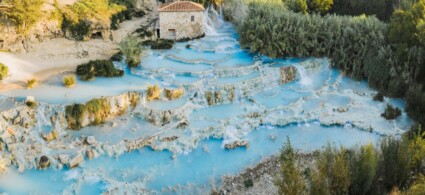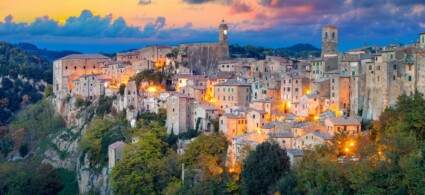

Located in the heart of the Maremma, in a plain crossed by the Ombrone river not far from the coast, Grosseto is the city in Tuscany recommended for those who want art and sea in the same day.
Probably founded in 935, Grosseto only took on its present appearance in the 20th century following the reclamation of the marshes in the surrounding area. The historical centre, enclosed within a well-preserved city wall, is rich in palaces, churches and museums with which you can feed your eyes with beauty. So did writers and film stars of the calibre of Italo Calvino, Sophia Loren, Dino Risi and Federico Fellini before you.
After a walking tour of the centre of Grosseto, take the car and head straight for the Maremma Natural Park: at this point you will have to choose whether to spend the day lying in the sun on a breathtaking beach or follow one of the park’s 16 itineraries to discover a great variety of plants and animals.
The wilderness is only a few minutes’ drive from the centre: a happy combination that makes Grosseto an ideal destination for a holiday in Tuscany outside the classic destinations. Perfect for a weekend, it is so easily loved that you will want to return for a whole week.
What are the must-see attractions in and around Grosseto? There is something for everyone: historical palaces, churches, museums, ancient ruins, natural parks… Here are the most interesting things to see in our opinion.
Piazza Dante Alighieri is the heart of Grosseto’s historic centre: the classic Italian piazza flanked by historic palazzi with elegant porticoes, a popular meeting place for citizens and venue for numerous open-air events. The current appearance of the square dates back to between the 13th and 14th centuries.
It is also called Piazza delle Catene or Piazza Duomo; the latter is a kind of small square within a square.
The centre of Piazza Dante is marked by the Monumento al Canapone, a 19th-century statue depicting Grand Duke Leopold II in the act of crushing the head of a snake: it is an allegory of the Maremma population’s victory over malaria.
Among the most beautiful buildings overlooking the square are the Duomo, Palazzo Aldobrandeschi and the Palazzo Comunale.
Set between Piazza Dante and the piazza of the same name, the Duomo di San Lorenzo is Grosseto’s architectural jewel, immediately recognisable by its white and pink stone facade.
Construction began in the late 13th century but the church was enlarged and modified several times over the centuries. The result is a breathtaking mix of styles and a riot of artwork.
Particularly beautiful is the portal, still quite faithful to its original appearance, with sculptural decorations depicting saints, floral motifs and symbolic animals.
Some of the most interesting works inside include the baptismal font by Antonio Ghini, the Gothic windows decorated by Benvenuto di Giovanni and a painting by Matteo di Giovanni.
Palazzo Aldobrandeschi is a magnificent neo-Gothic building constructed in the 20th century to the design of Tuscan architect and restorer Lorenzo Porciatto; it is inspired by the Sienese style of the Middle Ages. It is also known as Palazzo della Provincia.
The walls of Grosseto date back to the 13th century and are still visible today; they were damaged and rebuilt several times and their current appearance dates back to the works carried out in the second half of the 16th century at the behest of Francesco I de’ Medici.
The hexagonal perimeter of the walls and the ramparts at the corners can still be seen; however, almost all the guard posts on the ramparts have been destroyed and the outer moat has been filled in.
It is possible to walk on the walls, most of which have been transformed into a tree-lined pedestrian walkway. During your walk you will come across the gates that provided access to the old town and the preserved ramparts.
In order you will come across: Porta Vecchia, Bastione Cavallerizza, Porta Corsica, Bastione Molino a Vento, Bastione Garibaldi, Porta Nuova, Bastione Rimembranza, Bastione Fortezza (including Cassero Senese, Piazza d’Armi and Cappella di Santa Barbara), Porta Santa Lucia, Bastione della Vittoria and Bastione Maiano.
The Cassero Senese is perhaps the best known construction of Grosseto’s city walls: it is a tower with a rectangular base located above the Bastione Fortezza. It was built in the 14th century; the covered terrace was added in the 16th century.
Initially the tower had a defensive function, while later it was used as a collection point for salt extracted along the coast, which was then distributed from here: for this reason the tower is also called Cassero del Sale.
It is currently used as an exhibition and event venue.
Although much simpler than the Cathedral of San Lorenzo, the Church of San Pietro deserves to be included in the list of things to see in Grosseto. Its simple appearance should not deceive: it was in fact one of the most important churches in the city’s history.
It is a very old church; in fact, it seems that the original nucleus was already built between the end of the 8th century and the beginning of the 9th.
Four prestigious museums enclosed within a historic venue of great value: this is the Le Clarisse Cultural Centre, an important institution managed by the Fondazione Grosseto Cultura; the venue is the former convent of Santa Chiara, in the historic centre of Grosseto.
The ground floor houses the Gianfranco Luzzetti Collection Museum, which exhibits works of art created between the 15th and 19th centuries.
The first floor is occupied by Clarisse Arte, a space dedicated to temporary exhibitions and services for local artists such as an archive, a library and a media library.
One goes up to the third floor to visit the MuseloLab, a modern interactive museum that tells the history of Grosseto and its surroundings from the end of antiquity to the Unification of Italy.
The third floor also houses the Roberto Ferretti Ethnographic Collection, dedicated to the life and work of an important anthropologist who devoted much of his studies to the popular traditions of the Grosseto Maremma.
Just move 10 km from the centre of Grosseto to find a completely different world, totally immersed in nature. This is the Maremma Natural Park, a protected area stretching from the Talamone promontory to the mouth of the Ombrone river, established in the 1970s and affectionately called ‘L’Uccellina’ by the locals.
Covering an area of about 100 square kilometres, the park includes a wide variety of natural environments: sandy beaches, cliffs, marshes, pine forests and pastures.
The park can be explored on foot, by bicycle, on horseback, by canoe and even by carriage!
If you are an archaeology enthusiast, add the Roselle Archaeological Park to the list of attractions in and around Grosseto. About ten kilometres north of the centre, along the road to Siena, you will come across an area rich in Etruscan and Roman remains: this is the most important archaeological site in the Maremma.
These are the remains of the ancient city of Roselle, which stood on a hill about 150 metres above sea level, dominating the sea that at the time occupied the plain of Grosseto (later to become marshland and finally reclaimed). You can see the ruins of an Etruscan necropolis, the civil basilica, the forum, the baths, some Roman houses and an amphitheatre.
A downhill path leads to the Etruscan walls, which were once 3 km long and large sections of which have been preserved. Walking along the walls, you can admire a beautiful view of the Grosseto plain.
The proximity of the coast makes Grosseto a good base for a weekend or holiday combining sea and culture.
The nearest beaches are those of Marina di Grosseto, located only 15 km away and easily accessible both by car and public transport. The charming seaside village of Castigione della Pescaia can also be easily reached with a day trip (only 25 km away), as can Follonica (50 km).
Marina di Grosseto, Castiglione della Pescaia and Follonica are located north of Grosseto. If you go in the opposite direction, you can reach the enchanting beaches of Monte Argentario. The most famous places on the promontory, Orbetello and Porto Santo Stefano, are both about 50 km from the centre of Grosseto.
If you are an experienced diver, do not miss a dive in the waters of Le Formiche di Grosseto, three islets emerging from a 100-metre seabed.
The city of Grosseto does not have a tourist vocation: the most beautiful holiday accommodations are concentrated along the coast and in the countryside, some ten kilometres or more from the centre.
However, there are also solutions for those who prefer to sleep in the centre of Grosseto: it is possible to find a good choice of hotels, flats and b&b’s, mostly in the medium-low price range.
The city of Grosseto can be reached by car from the SS223 state road, which is connected to important arterial roads such as the Florence-Siena superhighway and the E80 Aurelia. It is therefore possible to arrive quickly from several directions.
For those travelling by public transport, the best solution is by train: Grosseto is located along the railway line connecting Rome to Pisa, served by frequent regional trains. More difficult, however, is to get to Grosseto by train from Florence: there are few direct trains, so plan for a change in Pisa or Livorno.
From Grosseto, it is possible to reach all the most important seaside resorts and villages in the Maremma by train. The bus is a good alternative to the train both to get to the city and to travel in the surroundings.
The city has a civil airport, but it is not served by commercial flights: if you want to arrive by plane, you should consider the airports of Florence, Pisa and Rome Fiumicino.
What's the weather at Grosseto? Below are the temperatures and the weather forecast at Grosseto for the next few days.
Grosseto is a municipality in southern Tuscany and is located in the central part of the Maremma; it is the capital of the province of the same name. It is about 150 km from Florence, 75 km from Siena and 160 km from Pisa.






